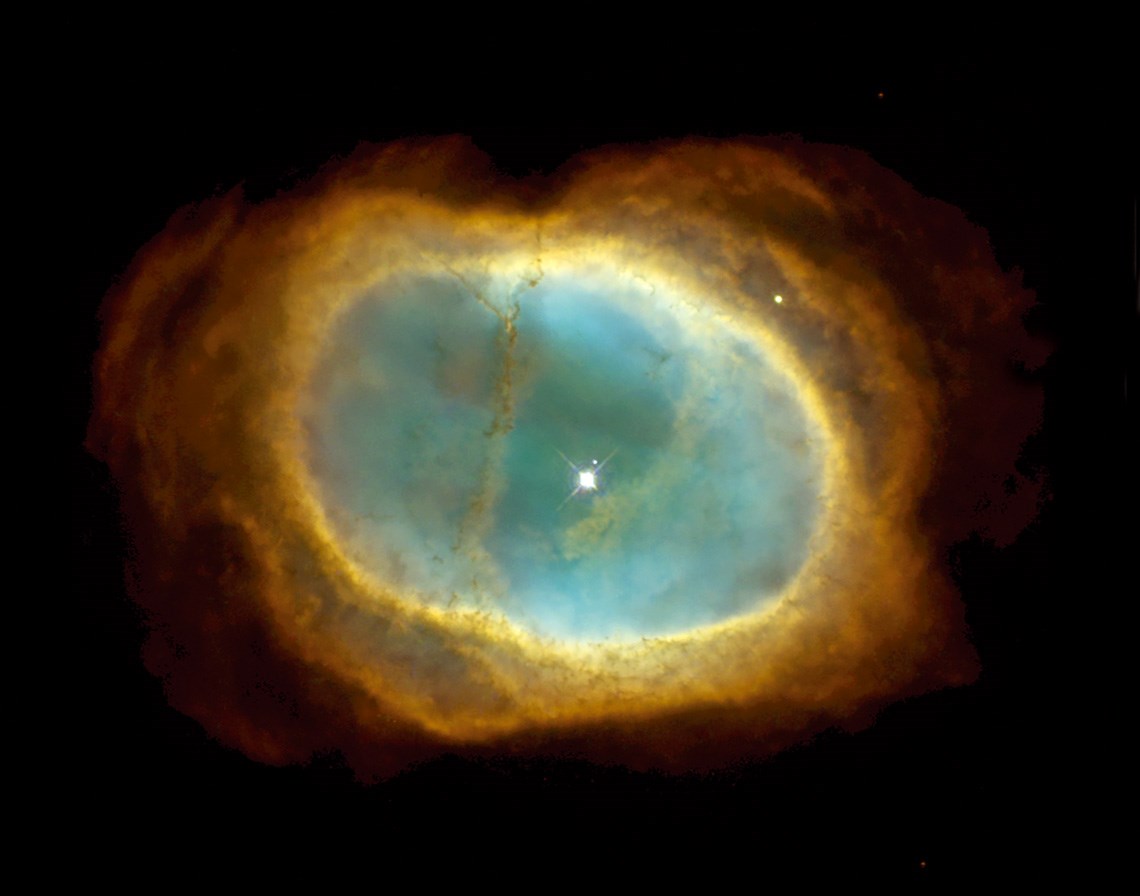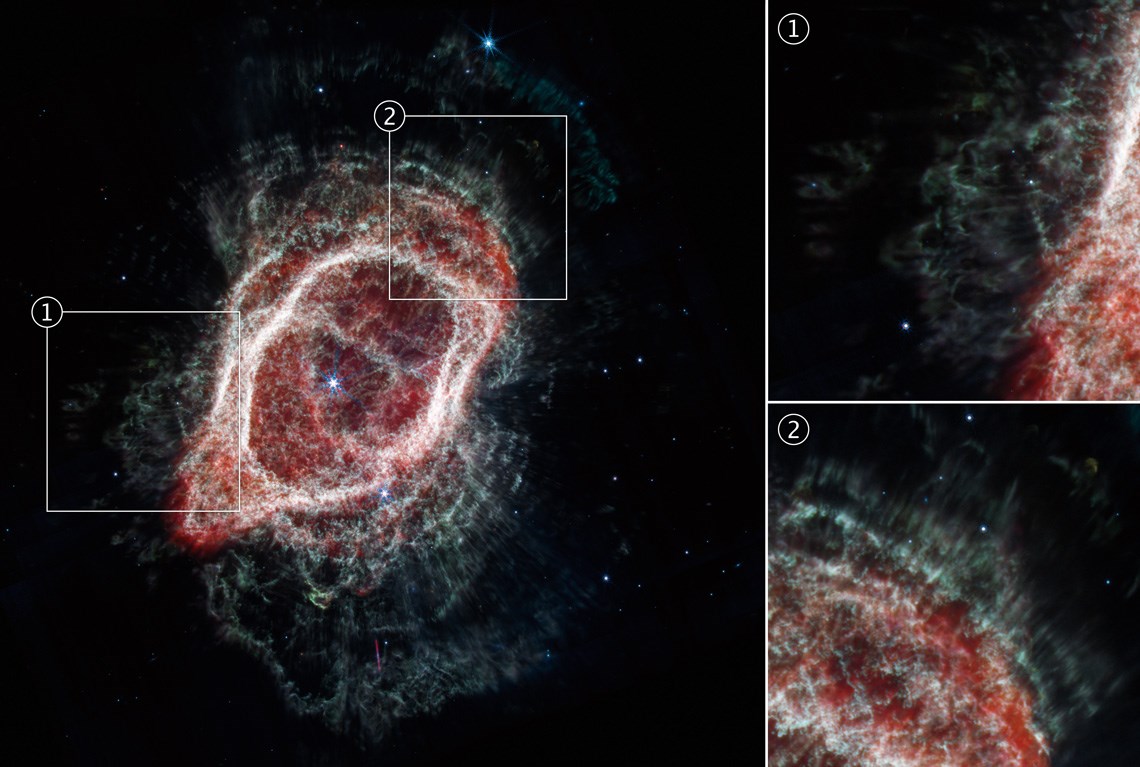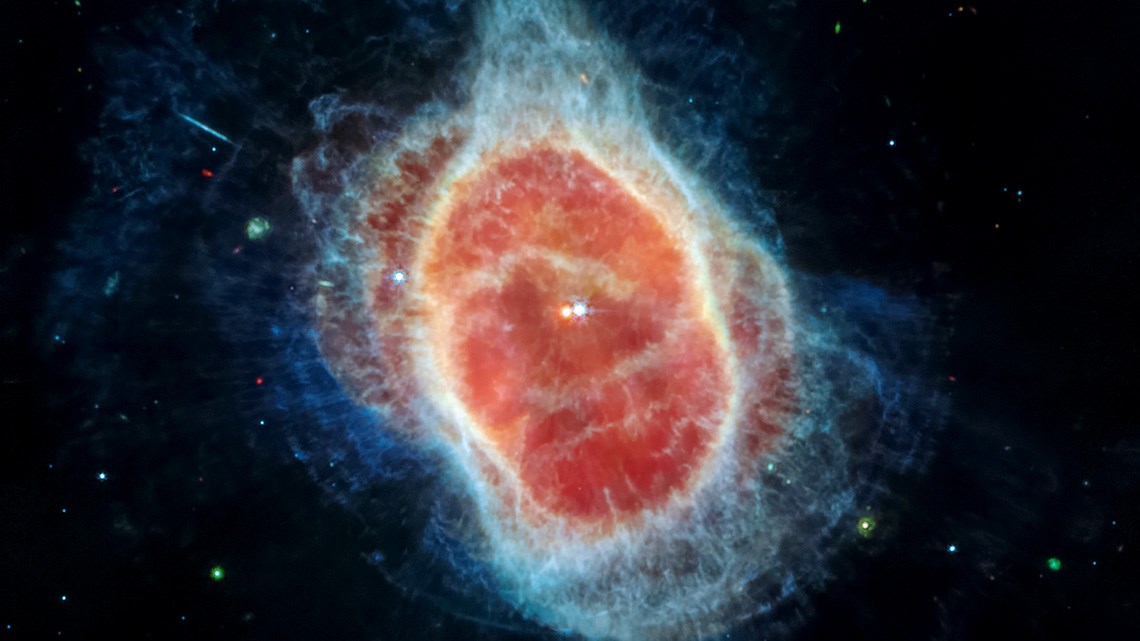In July 2022, the James Webb Space Telescope (JWST) released its first images of the Universe. One of the five celestial objects initially captured by the Webb observational instrument was the Southern Ring planetary nebula, which appears in astronomical catalogs with the designation of NGC 3132. It is a bright, oval-shaped cloud of gas and dust that surrounds a binary system, composed of two stars: an old and dying white dwarf and its younger brighter companion. A study published at the beginning of December in the scientific journal Nature Astronomy, which was started soon after the Webb images were released, proposed that the origin of the complex planetary nebula is not the consequence of just the interaction of two stars, but of at least four.
“The shape and characteristics of the nebula cannot be explained as resulting from the influence of just two stars,” says astrophysicist Isabel Aleman, of the Federal University of Itajubá (UNIFEI), in Minas Gerais, one of the authors of the article, made by an international team of almost 70 researchers. “As soon as we saw the images from the Webb, which contain many never previously observed details of the nebula, we decided to form a group with specialists from different fields to study it.” The astrophysicists made an informal call, open to all interested colleagues, on social media discussion groups, and quickly set up a virtual team to perform the study. Nobody had planned this work with NGC 3132, but the images from the Webb made it the appropriate time for the task.
In the article, the authors compare the images of the decline of the system’s central star, the white dwarf, with the events of a murder scene. Each picture can provide a clue of who took part in the crime. In the case of the nebula, the images from the Webb act like tip-offs about how many and what type of stars were in the neighborhood of the white dwarf when it started to lose its outer-most layers—the raw material used to form the ring and halo of the NGC 3132.
At the beginning of the nineteenth century, this type of celestial object was confused with gaseous planets. This perception did not resist the advances in scientific knowledge, but the name planetary nebula, even mistakenly, remained in use. These luminous formations are the final stage of life of stars that originally had between 1 and 8 solar masses. The Sun itself may generate this type of celestial object in its final stage. In the Southern Ring, which is about 2,000 light-years from Earth, the main star had 2.8 solar masses when it formed around 500 million years ago (the Sun appeared 4.5 billion years ago).
Around 2,500 years ago, this star ejected the majority of its external layers, formed of gases, and was reduced to a smaller and denser nucleus, around a fifth of its original size. It became a white dwarf, the classification used by astronomers for this type of dying star. The bright ring that characterizes planetary nebula is formed by the material lost by the white dwarf.

Hubble Heritage Team (STScI/AURA/NASA/ESA)Image from 1998 obtained by Hubble of the same nebula, with much fewer details than registered by the Webb telescopeHubble Heritage Team (STScI/AURA/NASA/ESA)
Today it is known that planetary nebulae generally form in systems in which the white dwarf has one or more companion stars. The presence of other celestial bodies close to the star affects the shape and other characteristics of the nebula’s bright ring. “In the past, when observation instruments were simpler, the images showed planetary nebulae with rings that appeared to be very round and simple,” comments astrophysicist Hektor Monteiro, also from UNIFEI, another author of the work and a specialist in the study of these objects. “Now, with space telescopes like the Webb, we see the details of these structures that show them to be much more complex.”
Launched in December 2021, the Webb captures images at different near- and mid-infrared wavelengths, invisible to the human eye, but which are emitted by all types of material, with the exception of mysterious dark matter. The article does not show images of these extra stars that are part or were part of the Southern Ring, but lists indirect evidence that would be a result of the presence, currently or in the past, of these celestial bodies.
“The largest mirror of the Webb collects more light and is able to see weaker structures,” says astrophysicist Orsola De Marco, of Macquarie University in Australia and lead author of the article, in an email interview with Pesquisa FAPESP. “At mid-infrared wavelengths, it is possible to study the coldest parts of the celestial objects.” The main mirror of the Webb telescope is 6.5 meters in diameter. It is almost three times larger than the Hubble telescope, of which it is a type of successor, and captures six times more light. However, the two telescopes operate at different frequencies of the electromagnetic spectrum. The Hubble telescope sees primarily visible light.

NASA, ESA, CSA, STScI, Orsola De Marco (Universidade Macquarie)Images from the Webb telescope show whitish structures formed by “rays” of ejected material on the edges of the ring of the nebulaNASA, ESA, CSA, STScI, Orsola De Marco (Universidade Macquarie)
Data was also used from other celestial observation instruments in the study, such as the Very Large Telescope of the European Southern Observatory (ESO), in Chile, the San Pedro Mártir Observatory, in Mexico, and the Gaia and Hubble space telescopes. The Soar telescope, in Chile, of which FAPESP is a partner, was another source of information for the study. “The main function of the data from Soar was to enable the determination of the three-dimensional structure of the nebula as a whole,” explains astrophysicist Claudia Mendes de Oliveira, from the University of São Paulo (USP), who was also a coauthor of the article about the planetary nebula. “This enabled the true distribution of the mass of the nebula to be determined and allowed better understanding of its chemical composition.” Astrophysicist Bruno Quint, who was doing his PhD at USP, is another Brazilian coauthor of the work, as is Denise Gonçalves, of the Federal University of Rio de Janeiro (UFRJ).
One of the clues that more than two stars took part in the formation of the nebula is the record of an excess emission of mid-infrared radiation around the companion star. “This data suggests the existence of a disk of dust around this star,” adds Monteiro. “The best explanation for this disk of dust is the presence of a third star in the center of the nebula that would have interacted with the companion and released material to form this structure.”
The images from the Webb telescope show, in rich detail, a halo composed mainly of molecular hydrogen gas (H2) around the central ring of the nebula with spiral shaped structures. This surface is interpreted by the authors of the study as a result of the existence of another hidden star, the fourth in the system, in the center of the nebula. The astrophysicists have also not ruled out the presence of a fifth star further from the center of the NGC 3132. “However, there is still no robust evidence of this fifth star in the nebula,” comments Aleman.
Projects
1. Exploring data from SAM-FP and T80-South (no. 19/11910-4); Grant Mechanism Regular Research Grant; Principal Investigator Claudia Lucia Mendes de Oliveira (USP); InvestmentR$204,658.25.
2. Science with the Brazilian robotic telescope (no. 19/26492-3); Grant Mechanism Thematic Project; Principal Investigator Claudia Luciana Mendes de Oliveira (USP); Investment R$3,779,503.69.
Scientific article
DE MARCO, O. et al. The messy death of a multiple star system and the resulting planetary nebula as observed by JWST. Nature Astronomy. Online. dec. 8, 2022.
